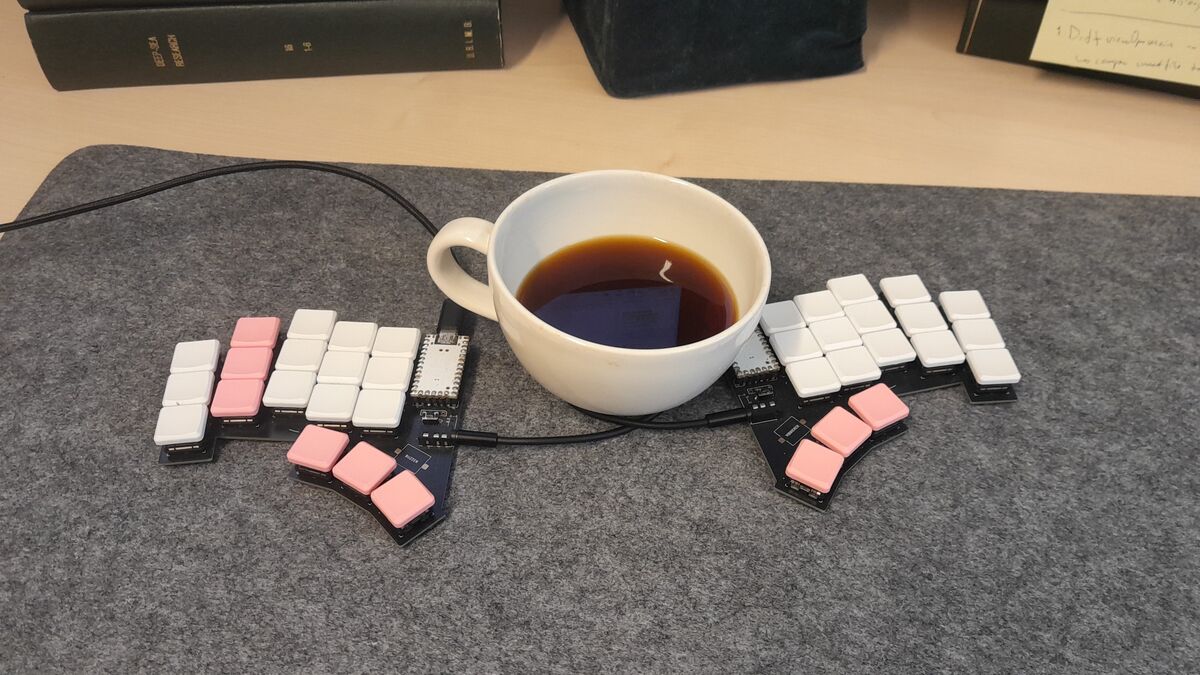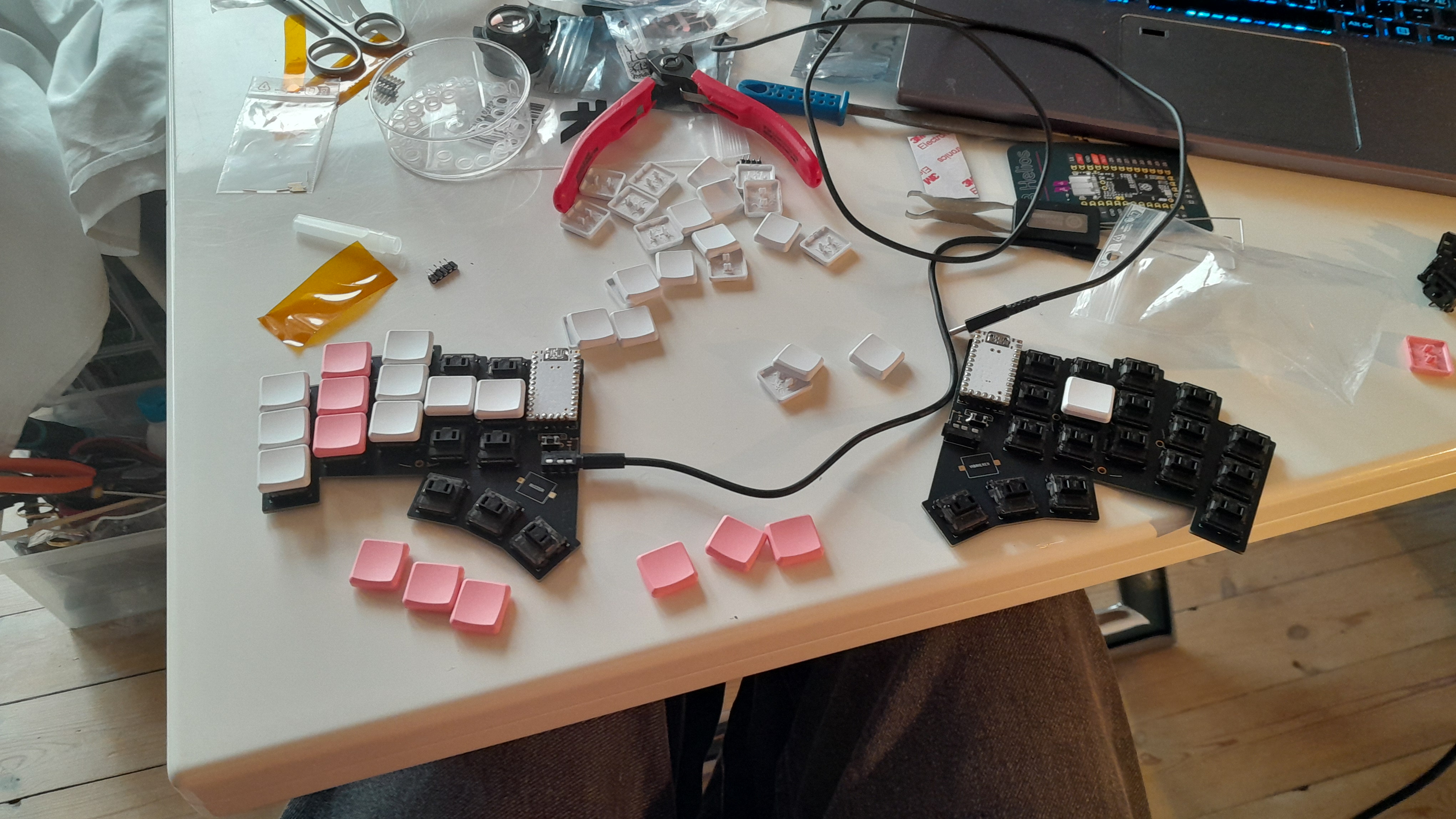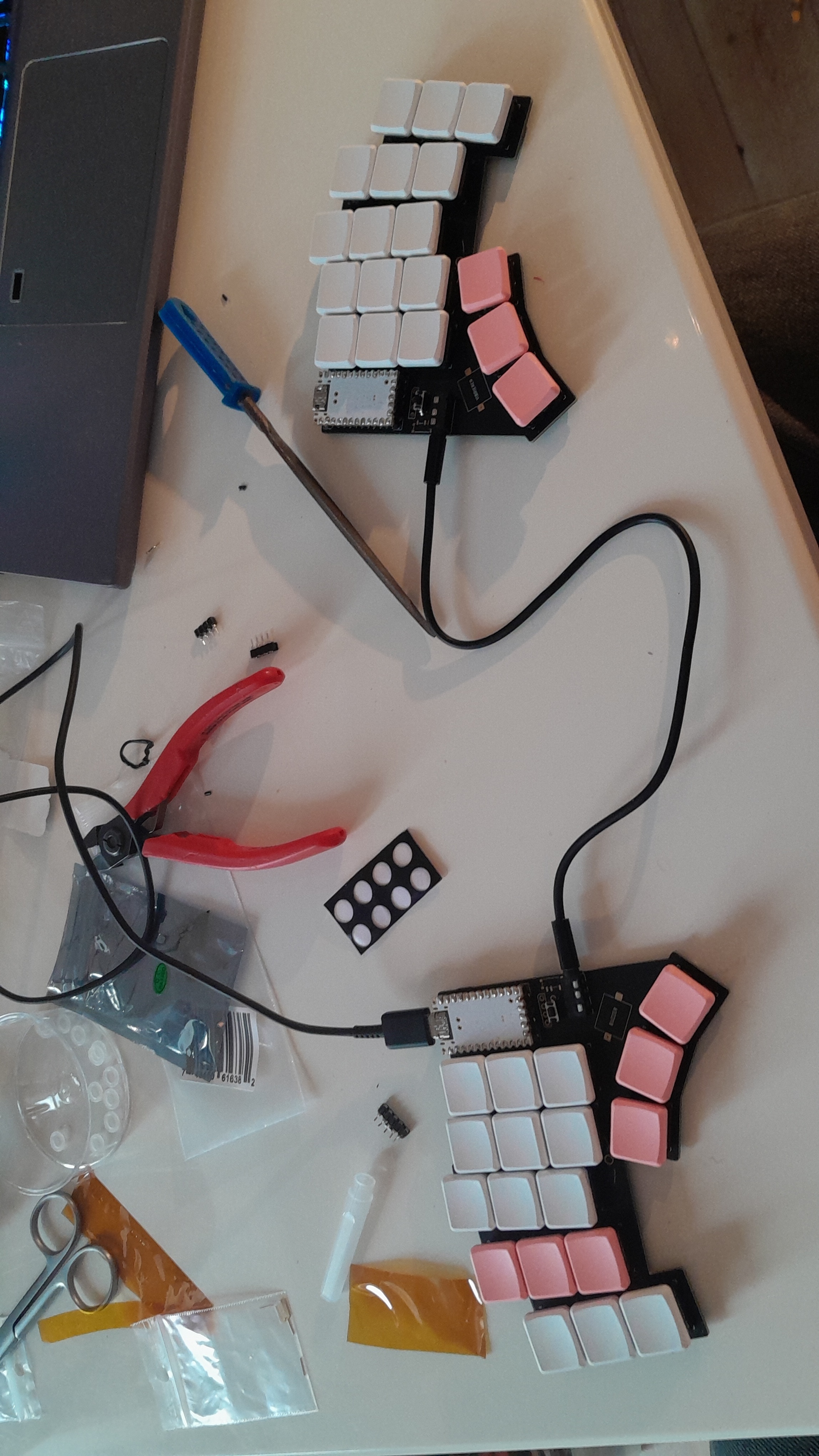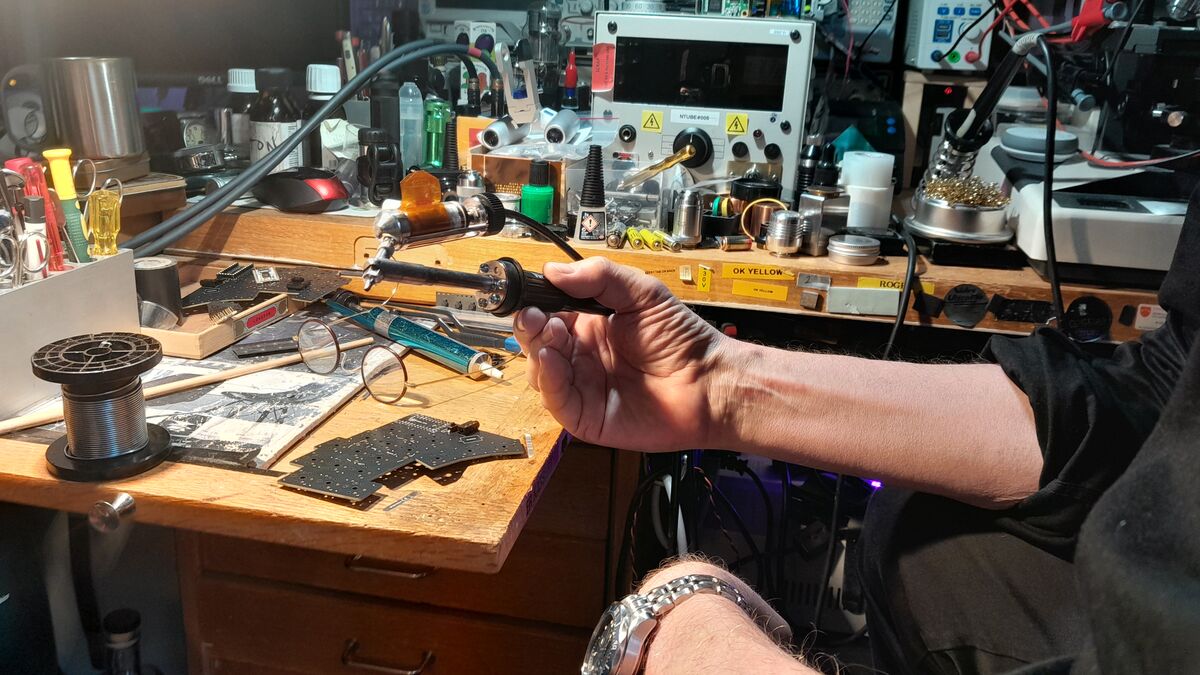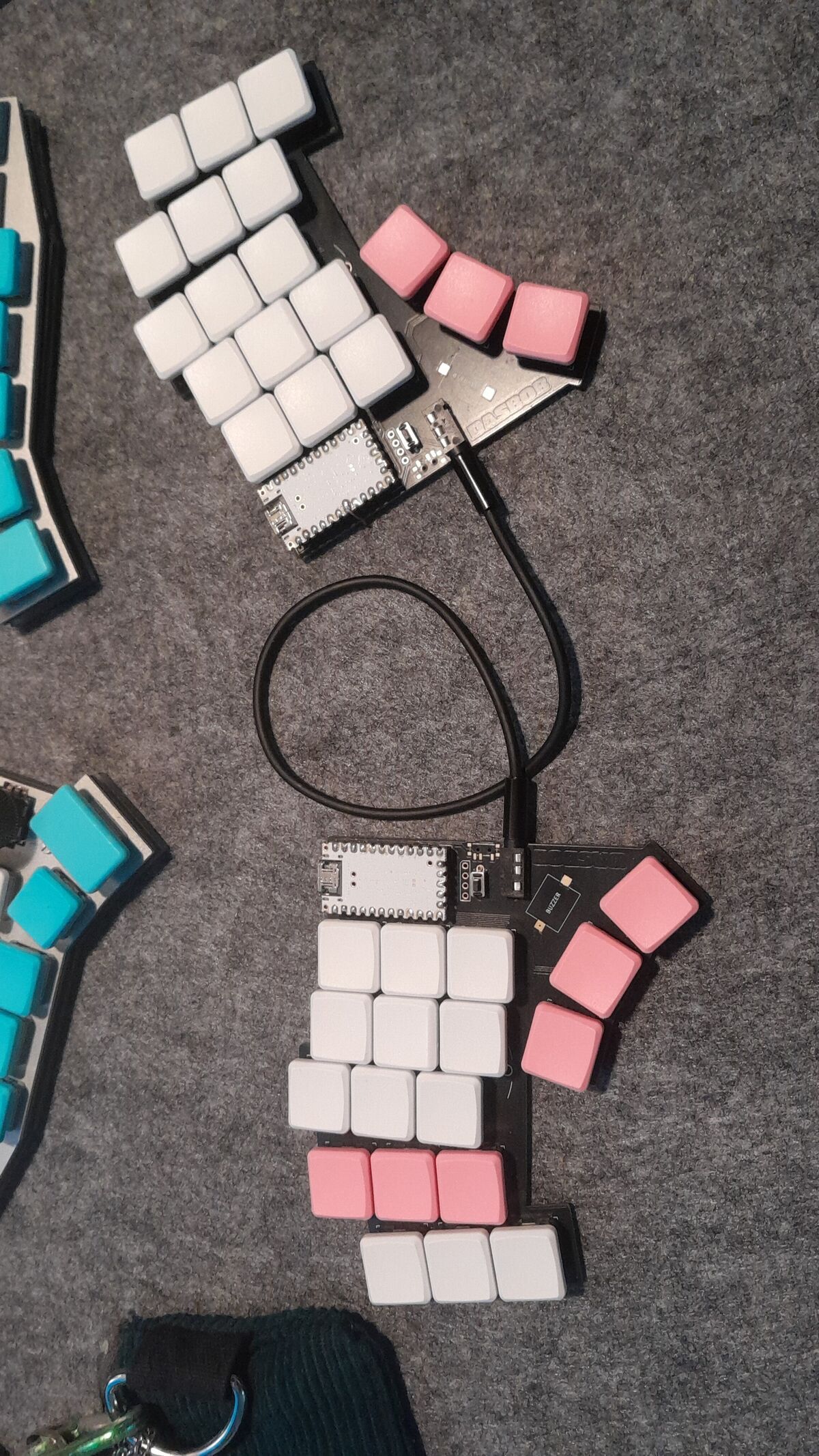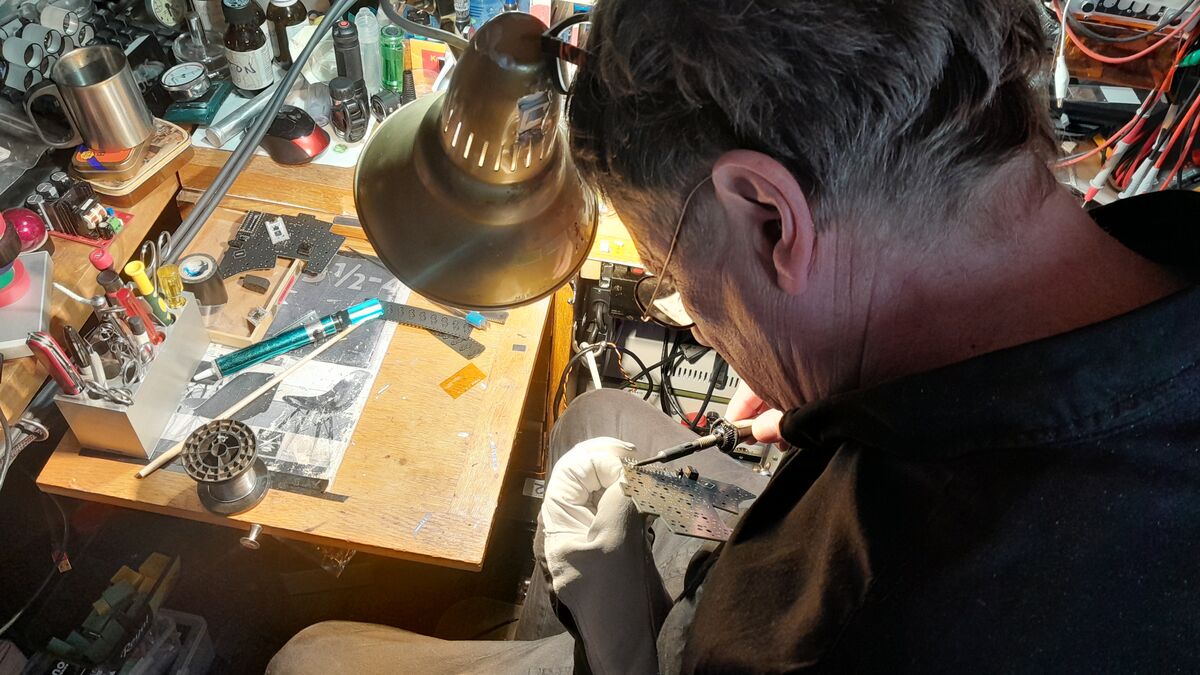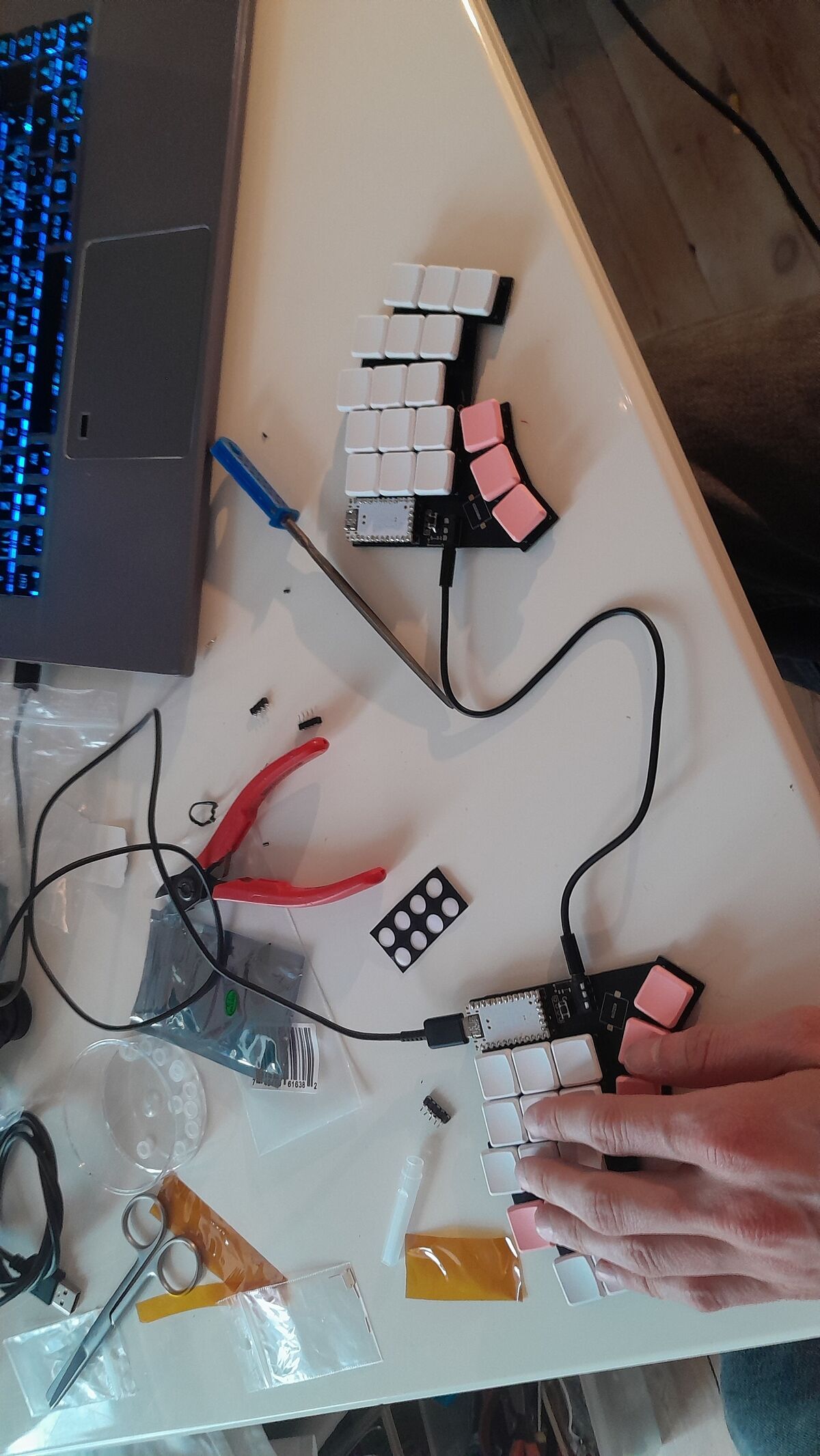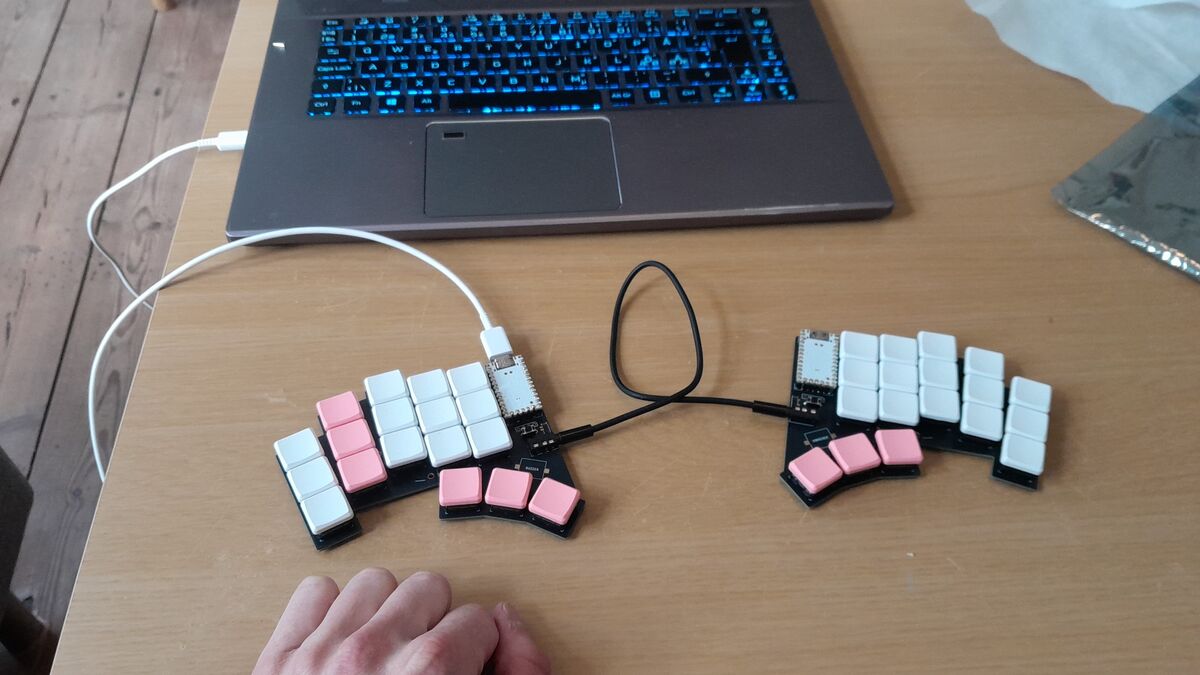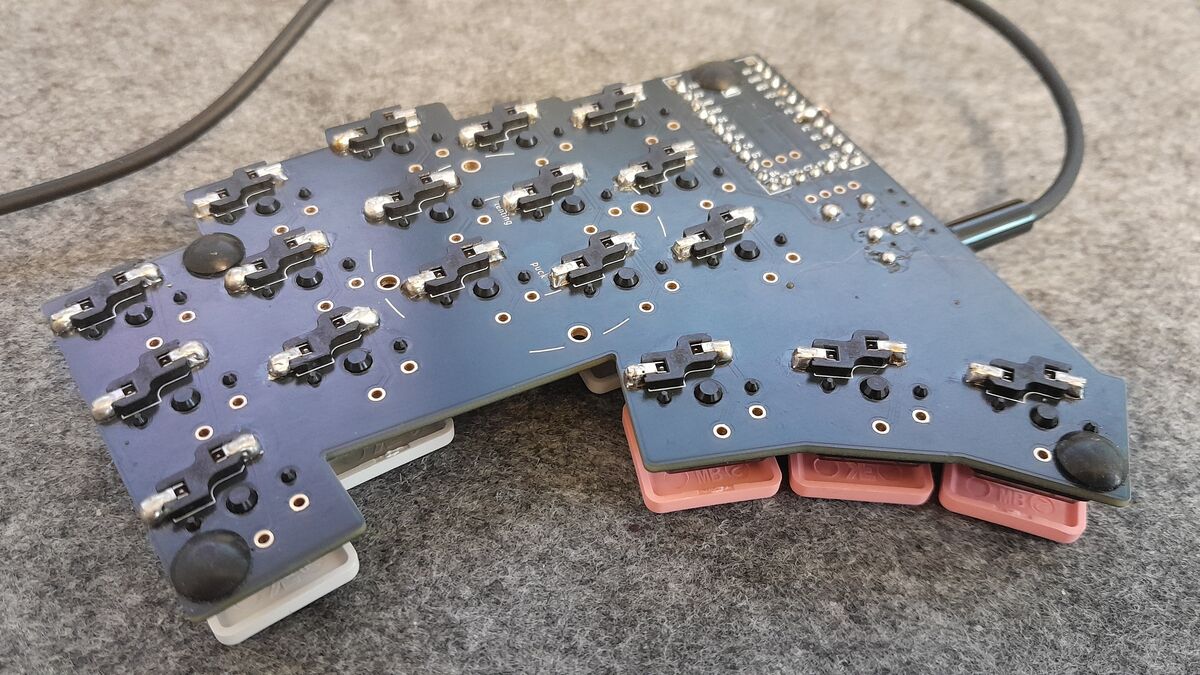▗▄▄▖▗▄▄▖ ▗▖ ▗▄▄▄▖▗▄▄▄▖ ▗▖ ▗▖▗▄▄▄▖ ▗▄▄▖▗▖ ▗▖ ▗▄▖ ▗▖ ▗▖▗▄▄▄▖ ▗▄▄▖ ▗▄▖ ▗▖ ▗▖ ▗▖▗▄▄▄▖▗▖ ▗▖▗▄▄▖ ▗▄▖ ▗▄▖ ▗▄▄▖ ▗▄▄▄ ▗▄▄▖
▐▌ ▐▌ ▐▌▐▌ █ █ ▐▛▚▞▜▌▐▌ ▐▌ ▐▌ ▐▌▐▌ ▐▌▐▛▚▖▐▌ █ ▐▌ ▐▌ ▐▌▐▌ ▐▌▗▞▘▐▌ ▝▚▞▘ ▐▌ ▐▌▐▌ ▐▌▐▌ ▐▌▐▌ ▐▌▐▌ █▐▌
▝▀▚▖▐▛▀▘ ▐▌ █ █ ▐▌ ▐▌▐▛▀▀▘▐▌ ▐▛▀▜▌▐▛▀▜▌▐▌ ▝▜▌ █ ▐▌ ▐▛▀▜▌▐▌ ▐▛▚▖ ▐▛▀▀▘ ▐▌ ▐▛▀▚▖▐▌ ▐▌▐▛▀▜▌▐▛▀▚▖▐▌ █ ▝▀▚▖
▗▄▄▞▘▐▌ ▐▙▄▄▖▗▄█▄▖ █ ▐▌ ▐▌▐▙▄▄▖▝▚▄▄▖▐▌ ▐▌▐▌ ▐▌▐▌ ▐▌▗▄█▄▖▝▚▄▄▖▐▌ ▐▌▐▙▄▄▖ ▐▌ ▐▌▐▙▄▄▖ ▐▌ ▐▙▄▞▘▝▚▄▞▘▐▌ ▐▌▐▌ ▐▌▐▙▄▄▀▗▄▄▞▘

Figure 1. My first split keyboard build!
As I recently got deeper into writing (and maybe more crucially: typing), I also got into writing devices. Mechanical keyboards may be great, but do you know what's even more great? ~Split~ mechanical keyboards! I didn't even know these things existed, and by now I'm pretty deep in the rabbit hole. As a consequence, I also learned manual soldering, use of microcontrollers, a little PCB design, and of course... writing in VIM. One of the key motivations for this journey was my senseless desire to write fast. A dear friend can type more than 100 words per minute (WPM). And I have now spent two years of my life trying to beat her.
The first experiment
Inexperienced and ready for anything, I went all out. I got the full Aurora Sofle v2 kit (Fig. 1), opting for the lucrative wireless microcontroller nice!nano. All I had to do was assemble and ZMK could build the firmware and flash the board via GitHub actions. It all sounded nice and smooth.
When the parts arrived my handy dad helped me with my first ever solder. Tiny diodes, transistors, sockets and other things I hadn't seen before, all went on the PCB. The keyboard halves came together. And then I tried typing.
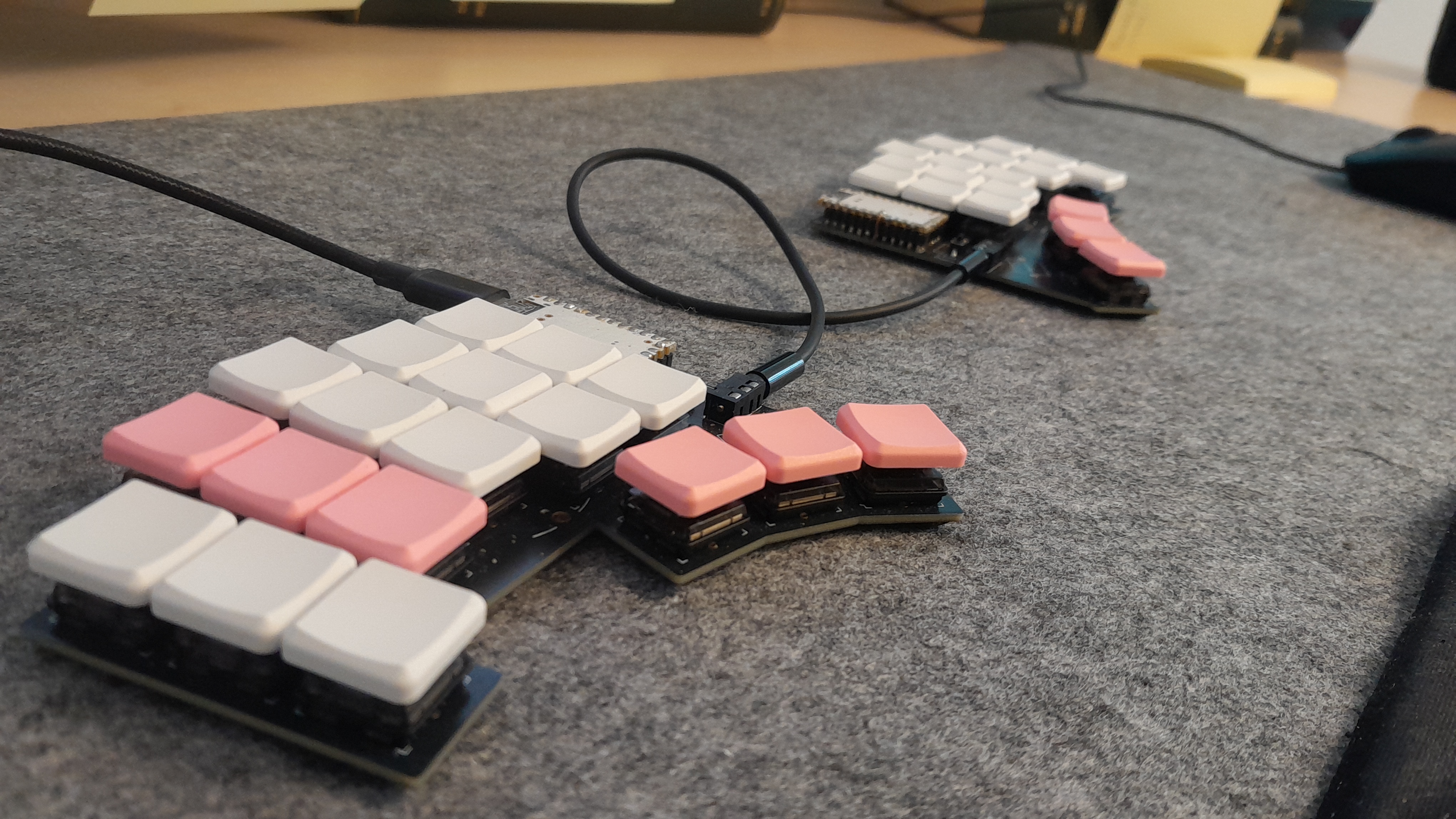
Figure 2. My second split keyboard build.
My first word
At some point in the research process I had discovered that to type faster, some builders choose mechanical switches with the lowest possible actuation weight. I had to beat my friend of course, so I got the Khail Chock Pink with 20g of required force. For reference, the average keyboard actuation force is around 50-70g... With the pinks, just the slightest touch is enough to activate a key.
The fool I am, I also lubricated the internal components of each switch, in an effort to silence the keyboard for office use. This made it even lighter to the touch. In the end, every key on my new build was working, but I could not type a single word. I kept accidentally hitting other keys when i rested my finger tips on the keyboard. After a grueling week of practice, I was up to a whopping 13 WPM. A bit shy of my friends score...
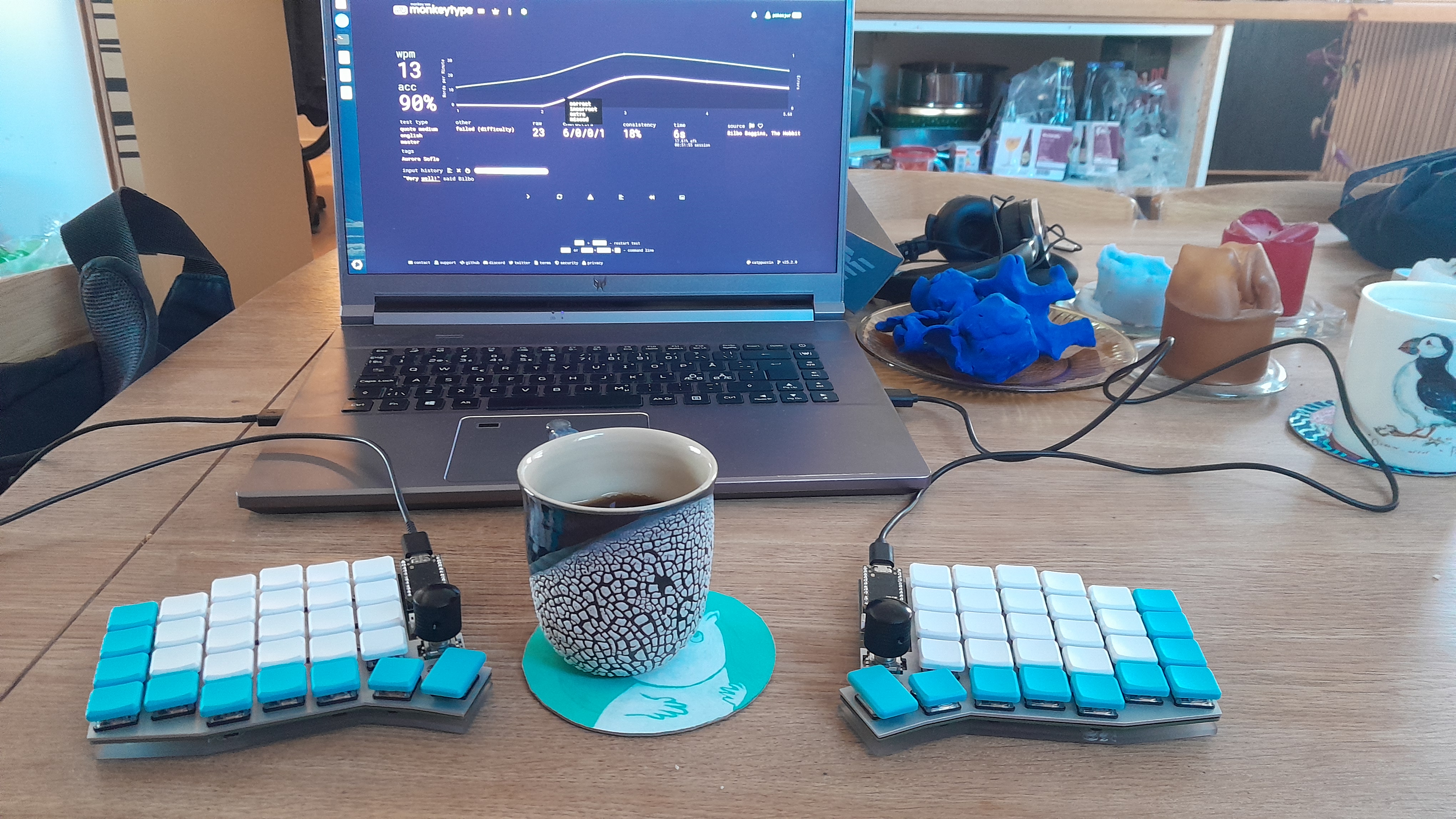
Figure 3. The first typing experience.
The second build
I got better eventually though, and I started to understand the power of a smaller keyboard. I wanted to build again. By now I had more experience and a better idea for what I actually needed. Who needs a number row when you can just change layers? Who needs dedicated CTRL, SHIFT, DELETE keys when you can place them right on the letter keys with hold-tap modifiers? Also, the fewer keys you have, the less you have to reach. All for the WPM's.
I got a 36-key layout this time. Just the letter-keys, and 3-thumb cluster keys per hand (Fig. 2). That should do it. Soldering went faster. Assembly went faster. But, when i tested the keys, the letter 'h' didn't work. Heck! We tested the microcontroller, we tested the switch, we even tested if the PCB had a connection between the switch socket and the placement of the microcontroller. Everything seemed fine, except that the button didn't work... Eventually we got it. An easy fix:
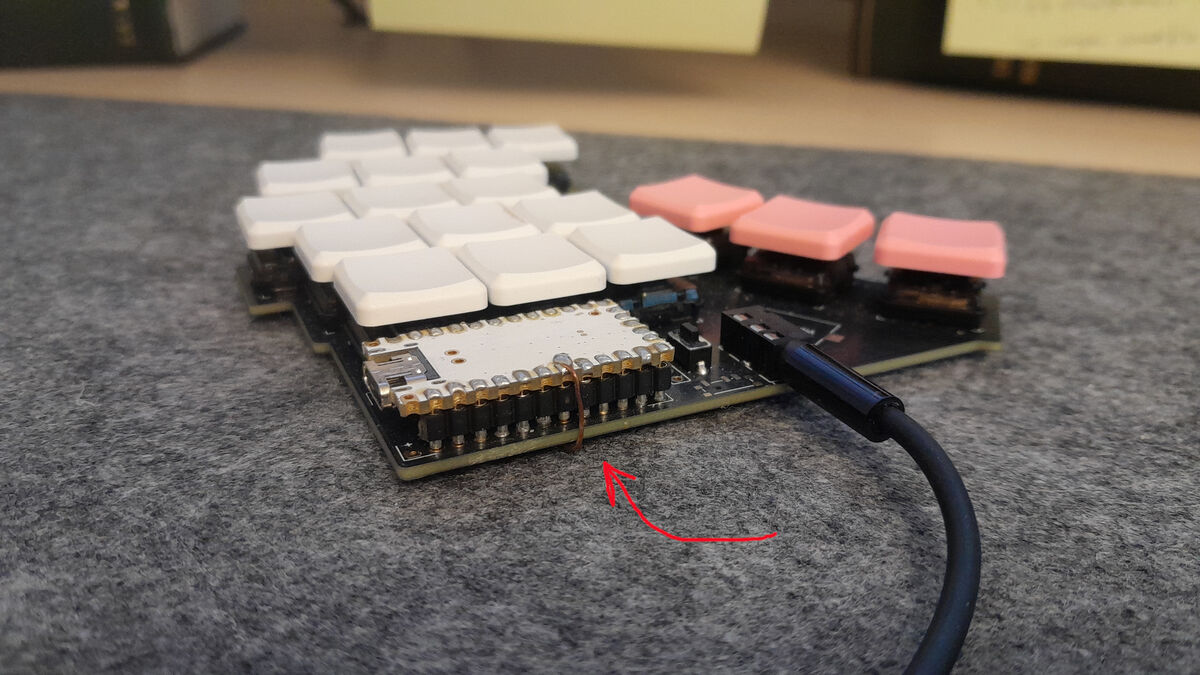
Figure 4. The fix. Not sure why, but the pin connecting the microcontroller to the board was ineffective.
The key map layout is also very important of course. I have made mine personal, inspired by many a config in the split board community. My current layout is explained in detail in my github repository. It's based on "home row mods" and combo keys. Home row mods are a way of changing the functionality of the normal `asdf`-keys. When I hold down my `f`-key, it acts as CTRL. It feels surprisingly fluid to type on And I can't recommend it enough. There is even software that can do these things on any old keyboard. For example kanata.
Despite all this wonderful work and research. I still can't type 100 WPM (not even close). But I'll keep practicing. Maybe one day.
